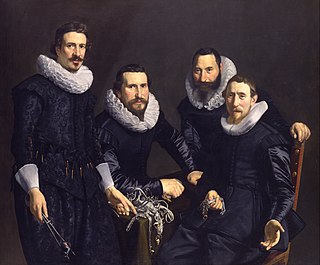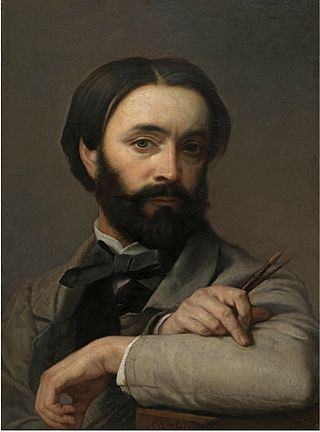Related Research Articles

Sir Constantijn Huygens, Lord of Zuilichem, was a Dutch Golden Age poet and composer. He was also secretary to two Princes of Orange: Frederick Henry and William II, and the father of the scientist Christiaan Huygens.

Willem van de Velde the Elder was a Dutch Golden Age seascape painter, who produced many precise drawings of ships and ink paintings of fleets, but later learned to use oil paints like his son.

Henri Leys, Hendrik Leys or Jan August Hendrik, Baron Leys was a Belgian painter and printmaker. He was a leading representative of the historical or Romantic school in Belgian art and became a pioneer of the Realist movement in Belgium. His history and genre paintings and portraits earned him a European-wide reputation and his style was influential on artists in and outside Belgium.

Thomas de Keyser was a Dutch portrait painter and a dealer in Belgium bluestone and stone mason. He was the most in-demand portrait painter in the Netherlands until the 1630s, when Rembrandt eclipsed him in popularity. Rembrandt was influenced by his work, and many of de Keyser's paintings were later falsely attributed to Rembrandt.

Hendrick de Keyser was a Dutch sculptor, merchant in Belgium bluestone, and architect who was instrumental in establishing a late Renaissance form of Mannerism changing into Baroque. Most of his works appeared in Amsterdam, some elsewhere in the Dutch Republic. He was the father of Pieter and Thomas de Keyser and Willem, and the uncle of Huybert de Keyser, who became his apprentices and all involved in building, decoration and architecture.
Raoul De Keyser was a Belgian painter who lived and worked in Deinze, Belgium.
Justus Sustermans, Joost Sustermans or Suttermans, his given name Italianised to Giusto, was a Flemish painter and draughtsman who is mainly known for his portraits. He also painted history and genre paintings, still lifes and animals.

Tobias Verhaecht (1561–1631) was a painter from Antwerp in the Duchy of Brabant who primarily painted landscapes. His style was indebted to the mannerist world landscape developed by artists like Joachim Patinir and Pieter Bruegel the Elder. He was the first teacher of Pieter Paul Rubens.

Andreas Schelfhout (1787–1870) was a Dutch painter, etcher and lithographer, known for his landscape paintings.
Jan Karel Donatus van Beecq was a Dutch marine painter, active in England and later in France, where he became a member of the Academy in 1681.

Nicaise de Keyser was a Belgian painter of mainly history paintings and portraits who was one of the key figures in the Belgian Romantic-historical school of painting.

Charles Verlat or Karel Verlat was a Belgian painter, watercolorist, engraver (printmaker), art educator and director of the Antwerp Academy. He painted many subjects and was particularly known as an animalier and portrait painter. He also created Orientalist works, genre scenes, including a number of singeries, religious compositions and still lifes.

Abraham de Vries was a Dutch painter who was one of the leading portraitists of his age. As he led a peripatetic lifestyle and worked in France, Antwerp and the Dutch Republic his stylistic qualities are difficult to pin down.

George Geldorp, Georg Geldorp or Jorge Geldorp was a Flemish painter who was mainly active in England where he was known for his portraits and history paintings. He was also active as an art dealer and impresario.

Mattheus Ignatius van Bree was a Belgian painter. He was one of the founders of the historical school of painting in Belgium and played an important role as a teacher in the development of 19th-century Belgian art.

Jan Baptist van Deynum, Dynen or Duinen (1620–1668), was a Flemish Baroque painter and a captain of the local civil guard in Antwerp. He is said to have painted portraits, genre subjects, history paintings and landscapes.

Jan van Pee, was a Dutch Golden Age art dealer and genre painter.
Simon Du Bois or Dubois ), was a portrait painter, of Flemish or Dutch origin, active in England from 1685 until his death.

Willem Hendrickszoon de Keyser was a Dutch Golden Age architect and sculptor primarily active in Amsterdam and London.

Willem Linnig the Younger was a Belgian painter and engraver who is best known for his history and genre scenes, landscapes and still lifes. He taught for some time at the Fine Arts School of Weimar.
References
 This article incorporates text from a publication now in the public domain : Bryan, Michael (1886). "DE KEYSER, Willem". In Graves, Robert Edmund (ed.). Bryan's Dictionary of Painters and Engravers (A–K). Vol. I (3rd ed.). London: George Bell & Sons.
This article incorporates text from a publication now in the public domain : Bryan, Michael (1886). "DE KEYSER, Willem". In Graves, Robert Edmund (ed.). Bryan's Dictionary of Painters and Engravers (A–K). Vol. I (3rd ed.). London: George Bell & Sons.- Willem de Keyser at the RKD databases